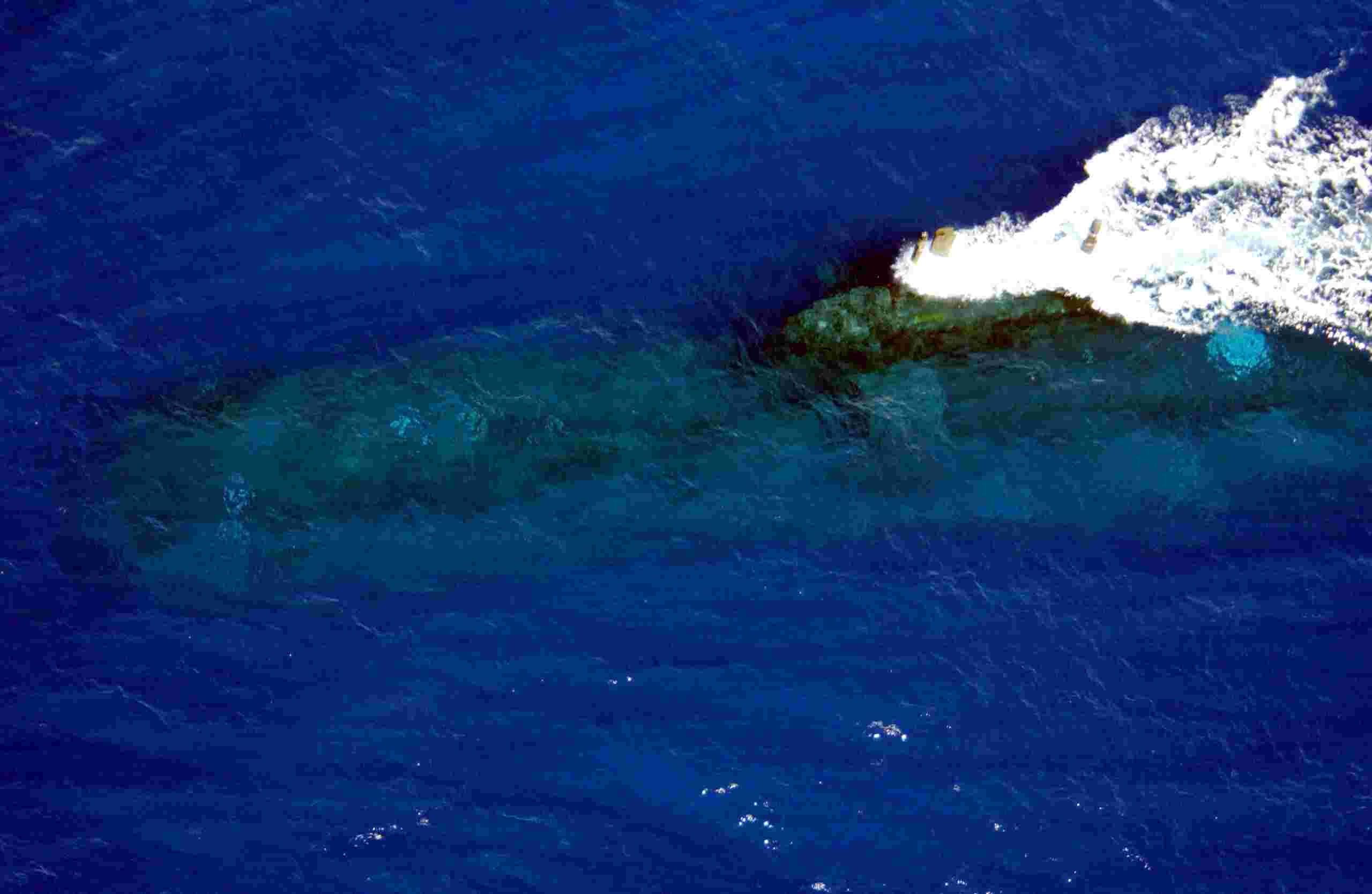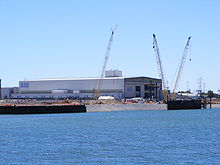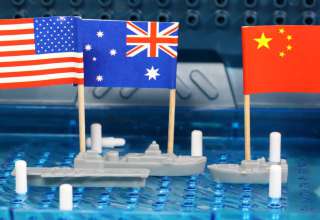 On Wednesday March 25, the Sub Summit was held at the Adelaide Convention Centre. It was a two-day conference on where and by whom Australia’s new submarines should be built.
On Wednesday March 25, the Sub Summit was held at the Adelaide Convention Centre. It was a two-day conference on where and by whom Australia’s new submarines should be built.
Spirit of Eureka members handed out leaflets to attendees in support of an Australian build, by Australian workers, of Australian submarines.
They also protested the broken promise of not to build the new submarines in Australia by the Abbott Government.
Below is the text of the leaflet, followed by an open letter from Rod Fayle, former RAN submarine commander. Fayle argues a positive case for the ‘Collins Class’ submarines and their Australian manufacture.
Tell Abbott to build our subs here!
Ian McPhedran is the National Defence Writer for News Corp. In an Advertiser article on 11 March he confirmed our position that the proposal for a Japanese build is all about US strategic interests. It is not about our sovereignty. It is not about our future and our jobs.
McPhedran quotes two retired Japanese admirals, scheduled to speak at the Summit, as supporting the proposed Japanese build as it will provide “strategic and operational flexibility to the USA’s rebalancing policy” in East Asia.
One of the two admirals, Yoji Koda, has written elsewhere of how Japan has worked to construct a major navy despite the post-WW 2 Constitution of Japan, Article 9 of which states that “the Japanese people forever renounce war…and the threat or use of force as a means of settling international disputes…land sea and air forces…will never be maintained”. Koda has boasted that the so-called Maritime Self-Defence Force “was determined to maintain and hand-down the good culture and spiritual heritage from the Imperial Japanese Navy”, that same Navy which served Japan’s aggression and expansion in WW 2.
It is unacceptable for Australian sovereignty to be dependent on the military capacity of a country currently seeking to undermine its own Constitution and to line up with the US in whatever confrontations it creates in our region.
Koda says that “What the United States and its allies, especially Japan and Australia, have to do now is send a clear signal to China by showing close cooperative postures and real combined military capabilities.”
It is unacceptable for Japan and the US to tell Australia what is should do in relation to China, a country with which we have good relations.
It is unacceptable for an aggressive US and Japanese military policy to be underwritten by a $40 billion submarine contract when we are perfectly capable of building those submarines here.
It is also unacceptable for that same contract to underwrite changes to Japanese policy which have previously forbidden the export of arms made in that country.
According to the Japan Times (Jan 18, 2015) “If the deal goes through, the top-secret submarines will become the first major pieces of military hardware Japan has authorized for export since the administration of Shinzo Abe lifted the decades-long blanket ban on arms sales last year.”
Our jobs and $40bn of our taxes must not be used to help Abe break his own country’s Constitutional ban on weapons exports.
Abbott is meant to be the Prime Minister of and for Australia, not some cheap agent of outside powers.
ASC workers have more interest than most in making clear to Abbott our rejection of his toadying to the US and Japan.
Please do what you can to encourage people to stand with us from 8am to 9am next Wednesday at the Convention Centre.
Demand that Australian workers build Australian subs!
Open Letter on the Collins submarines
by Rod Fayle
Commander RAN Retired
 I continue to be confronted and annoyed by the repeated negative claims and distortions being reported in the Australian media about submarine matters. What started as an orchestrated miss-information campaign against the Collins submarine has now spilt over to the next generation of submarines. Why is it so? Our modest submarine force of 6 Collins class boats is a major part of Australia’s Defence Force. Our defence policy is based on deterrence and modern, capable submarines provide a very powerful deterrence. But repeatedly, we are being told that our Collins submarines are “duds”, that the “building of those submarines in Australia was an expensive disaster”, and now “we are going to do it again”.
I continue to be confronted and annoyed by the repeated negative claims and distortions being reported in the Australian media about submarine matters. What started as an orchestrated miss-information campaign against the Collins submarine has now spilt over to the next generation of submarines. Why is it so? Our modest submarine force of 6 Collins class boats is a major part of Australia’s Defence Force. Our defence policy is based on deterrence and modern, capable submarines provide a very powerful deterrence. But repeatedly, we are being told that our Collins submarines are “duds”, that the “building of those submarines in Australia was an expensive disaster”, and now “we are going to do it again”.
My reason for writing this letter is to try and set the record straight. I will argue that the Collins project was, in many ways, a remarkable success, both as an industrial build and operationally, having produced a highly effective submarine. That is not to say that there were not some problems. At the coal face, these problems were identified and solved whereas, at the political level, it seems that issues were seized upon, blown out of all proportion and repeated time and time again, creating the widespread impression of a “dud” submarine. Playing politics with a major part of Australia’s Strategic Defence should not occur. Have an informed debate by all means but keep the politics out of it.
Where to start? A project like building of the Collins submarines is large and complex. There have been many reviews and reports written about the project and I would direct anyone who would like more details than can be covered in this letter to a book “The Collins Submarine Story; Steel Spin and Spies” by Peter Yule. The author had no involvement with the project, had no axe to grind, conducted a very large number of interviews with people from all sides of the project, and produced a warts and all and balanced analysis. The book should be compulsory reading for all those Canberra based politicians and bureaucrats who are now considering the new submarines.
Firstly, let me say that, having finally allocated the required resources (manpower, spares and maintenance) the submarines are now performing very well and the manpower problems are being overcome. Perhaps our strongest supporter is the highly acclaimed United States submarine service and that should say it all. The Americans also visited us many times during our build program and have adopted concepts such as modular design and build, performance contracts, and combat system concepts in their own submarine programs. They are great admirers of what we have achieved and are mystified by the paucity of the political debate and lack of support for such an important element of our Defence Force though they would not be so impolite to say so.
Exceptionally quiet
As a former submarine Commanding Officer, it is the operational miss-information that I find most objectionable. There are many aspects that define a submarines effectiveness but above all, the submarine must be quiet. It owes it’s existence to the fact that a very quiet submarine can virtually disappear. If the opposition cannot find you, and you have the necessary fire-power to seriously hurt an aggressor, you create a very real deterrent. That is what our submarines are about. So what is this rubbish that we keep hearing about the Collins submarines being noisy? Nothing could be further from the truth. In the early days of the first boat, there were two noise issues, a poorly manufactured propeller and some water flow noise problems. These were both solved long ago and for many years, the boats have been exceptionally quiet. The noise levels are so low that it has been very difficult to find an area where we can measure their noise. The boats are quieter than the background noise in the ocean. This characteristic alone sets the Collins boats very high on the effectiveness scale and we should all be very proud of what we have achieved.
Combat systems
 Another operational feature that is still being “bagged” is the combat system. For the uninitiated, the combat system includes all the sensors (many different sonars for underwater listening, periscopes for visual and optronics, passive and active radar), communications, navigation, all the weapons stuff, and what we call the Tactical Data Handling System where all the information is processed and displayed to the operators. We set the requirements for the combat system in the mid 1980’s based on our very successful modernisation of the Oberon Class combat system. We were not trying to invent some new technology but we were trying to predict the technology that would be available some years ahead (due to the protracted nature of Defence contracts).
Another operational feature that is still being “bagged” is the combat system. For the uninitiated, the combat system includes all the sensors (many different sonars for underwater listening, periscopes for visual and optronics, passive and active radar), communications, navigation, all the weapons stuff, and what we call the Tactical Data Handling System where all the information is processed and displayed to the operators. We set the requirements for the combat system in the mid 1980’s based on our very successful modernisation of the Oberon Class combat system. We were not trying to invent some new technology but we were trying to predict the technology that would be available some years ahead (due to the protracted nature of Defence contracts).
The successful prime contractor for the combat system was the large American company Rockwell, who put together a strong international team of equipment specialists. Rockwell was to integrate the equipments. It is fair to say that the company did not cover itself in glory, but never-the-less, a combat system was delivered with some shortcomings.
As time moved on, new technologies became available (readers may remember that laptop computers were not available in the mid 1980’s and smart phones only came along around 2005). Funds that should have been available to keep the combat system up to date were removed. When it became obvious that the upgrade was essential, there was a self inflicted drama requiring the funds to be re-allocated. So now we have a combat system that incorporates modern technologies, with support from the US Submarine service. It is a very capable system and makes the submarine a formidable opponent to any potential aggressor. This capability is repeatedly demonstrated and acknowledged in advanced war-games with our allies.
Crew shortages and serviceability
Another area of concern highlighted by the detractors has been the shortage of crews and poor serviceability of the submarines. These problems were real. They were brought about by the reluctance of the relevant authorities to provide the required level of support. The resultant shortages in spares, maintenance dollars and trainee crews were exacerbated by the ongoing “bagging” of the Collins. The poor image impacted on morale and, at the same time, the mining boom provided very attractive wages and conditions for our highly qualified personnel. Not surprisingly, we had manpower problems. A few years ago, the Department finally accepted the need to properly support our submarines and corrective measures have been put in place. While the years of neglect will not be resolved overnight, there have been substantial improvements and there is a clear pathway to build crews and other support arrangements for the next generation of submarines.
An Australian build?
My comments would not be complete without reference to the contemporary debate about the new generation submarines, their capability and whether they should be built in Australia. I write with the benefit of many years at sea, deep experience with the Oberon modernisation and Collins projects and an ongoing interest in Defence matters, particularly submarines. I am a member of the Submarine Institute of Australia, a think tank set up to provide a vehicle for informed discussion on submarine matters. My comments are my own and not necessarily those of the Department of Defence or the Institute.
On the capability issue, the requirements are derived from the roles our submarines are expected to perform. My assessment is that this will require a submarine of similar capabilities to the Collins, what has been described as an “Evolved Collins”. Such details should be left to the current submarine community. It will be they and their successors who will have to operate the boats and it is they who know the critical issues for an effective submarine.
On the numbers required, many studies have shown that you need 12 submarines of this type to produce an effective deterrent. There will be other reasons put forward for “how many”. One such argument will be the need to establish a “continuous build” arrangement. The Japanese are a case in point. Much has been said about Option “J”, i.e. having the submarines built by Japan in Japan to the current Japanese submarine design. The Japanese have had an excellent “continuous build” program going for their submarines for many years and that has allowed continuity of workforce and skills as well as the evolution of the submarine design over time. While the design of the Japanese submarine is not suitable for Australia, their build and design evolution concept is certainly relevant.
 On the question of an Australian build, I have trouble answering why not. Do we still have some sort of cringe or fear? Come on Canberra. We can do it. We have just proven that with the Collins. We have also completed a very successful similarly complex Anzac Ship build program in Melbourne. We build huge infrastructure projects. We are a capable nation and if we need some particular skill, we can get that as we did with the Collins project. What are we worried about? Is it risk? Everything we do has some risk but we should not be so risk averse that we do nothing. Risk can be mitigated by proper planning and we need to get on with the job. By taking on a suitable experienced submarine builder as a partner, risk can be kept under control. It should be remembered that our “Deterrent” posture is a combination of factors including the capability of the submarine, the skills of our crews, our support facilities, our actual support, and our political will. If we don’t have an Australian build and a committed Government, I suggest our “Deterrent” credibility will be significantly reduced. What about cost? Clearly we need to get value for our money. The Collins project showed us that it can be done in Australia without any significant cost penalty and that is before looking at the negative foreign exchange issues of spending billions of dollars off-shore and the positive flow on effect of spending money in Australia.
On the question of an Australian build, I have trouble answering why not. Do we still have some sort of cringe or fear? Come on Canberra. We can do it. We have just proven that with the Collins. We have also completed a very successful similarly complex Anzac Ship build program in Melbourne. We build huge infrastructure projects. We are a capable nation and if we need some particular skill, we can get that as we did with the Collins project. What are we worried about? Is it risk? Everything we do has some risk but we should not be so risk averse that we do nothing. Risk can be mitigated by proper planning and we need to get on with the job. By taking on a suitable experienced submarine builder as a partner, risk can be kept under control. It should be remembered that our “Deterrent” posture is a combination of factors including the capability of the submarine, the skills of our crews, our support facilities, our actual support, and our political will. If we don’t have an Australian build and a committed Government, I suggest our “Deterrent” credibility will be significantly reduced. What about cost? Clearly we need to get value for our money. The Collins project showed us that it can be done in Australia without any significant cost penalty and that is before looking at the negative foreign exchange issues of spending billions of dollars off-shore and the positive flow on effect of spending money in Australia.
Industrial relations is another red herring. On the Collins project, site specific workplace arrangements were negotiated before the contract was signed and the project was completed over 10 plus years without any significant demarcation or other industrial issues. The Federal Government is now the sole owner of the ASC in Adelaide and it is their responsibility to negotiate suitable workplace arrangements. From what I see in the media, the Government seems to have lost the will (or skill) to negotiate, not just at ASC but in the Senate as well.
Much has been said about the type of tender that might be offered. My view is that an open tender would not be appropriate but a competitive restricted tender would achieve the desired outcome. i.e. the best product at the best price. The tender should include pricing and conditions for an Australian build.
In conclusion, let me reassure all Australians that the Collins submarine is a very capable submarine, probably the best of it’s kind in the world. The next generation submarines can and should also be built in Australia.






